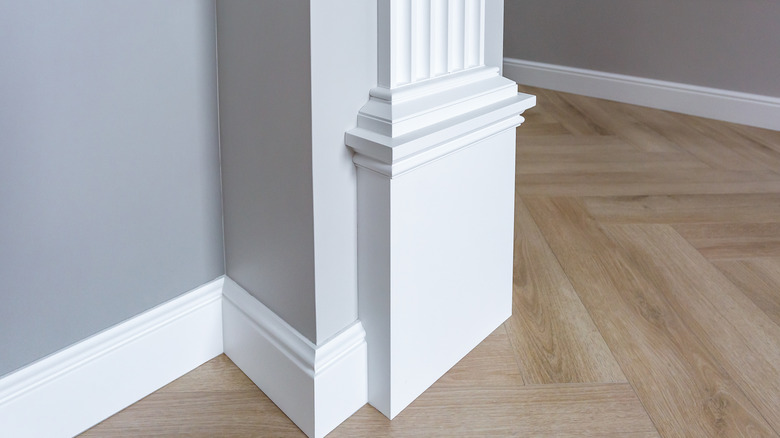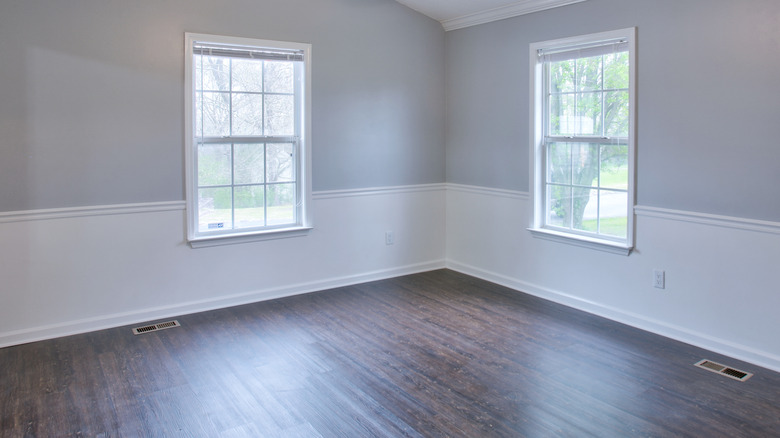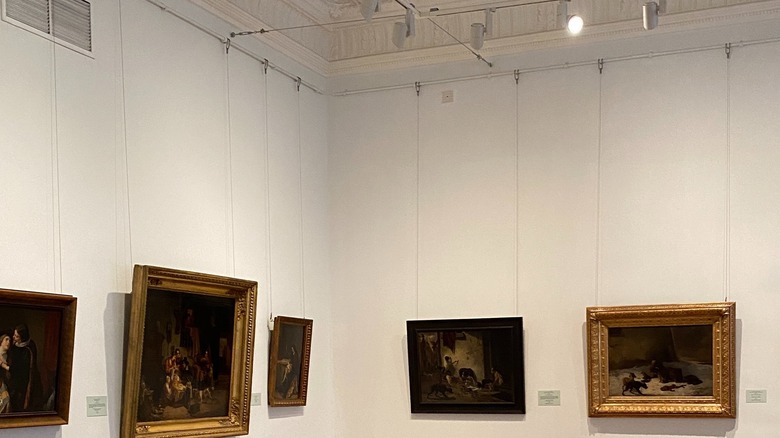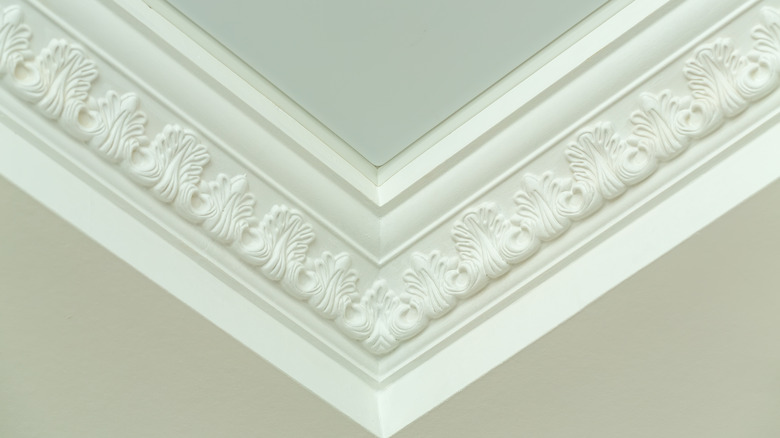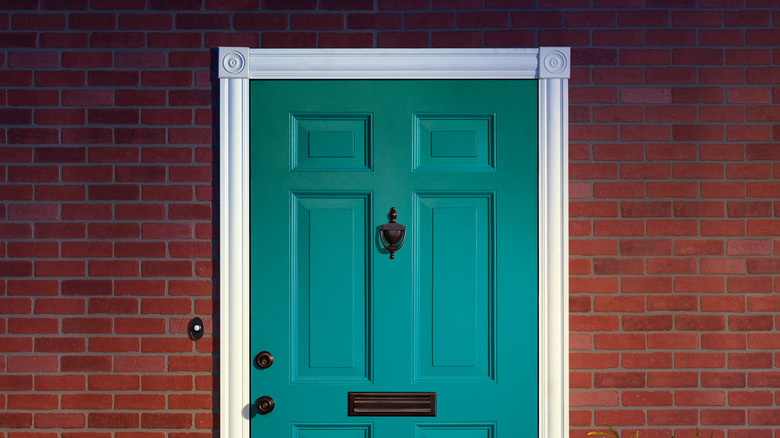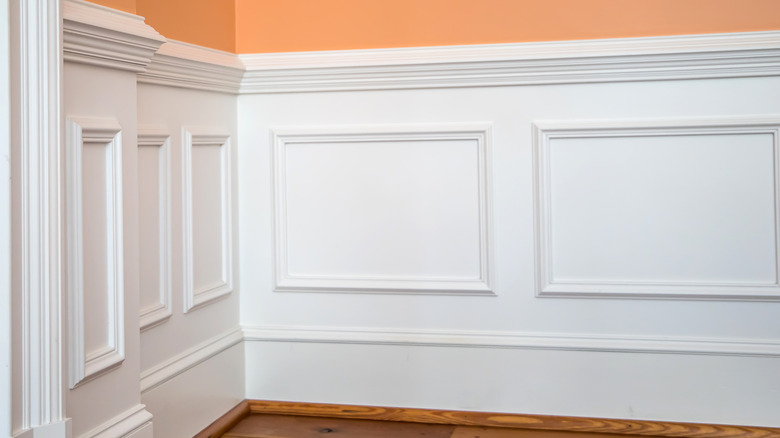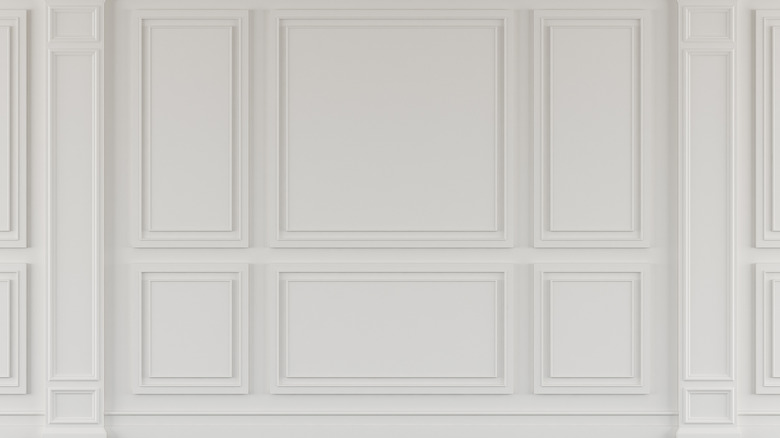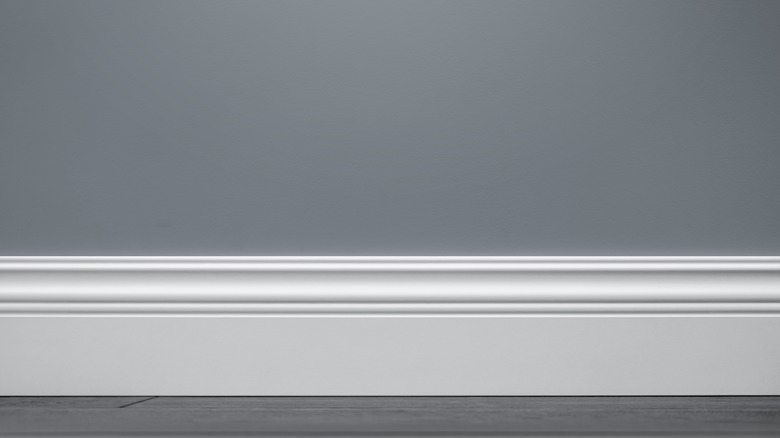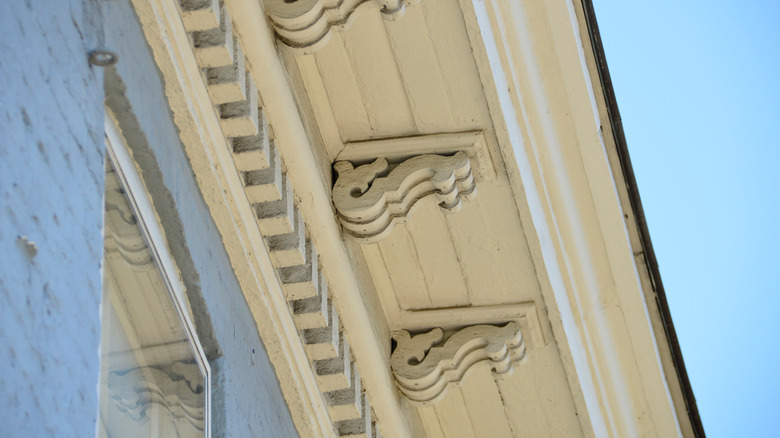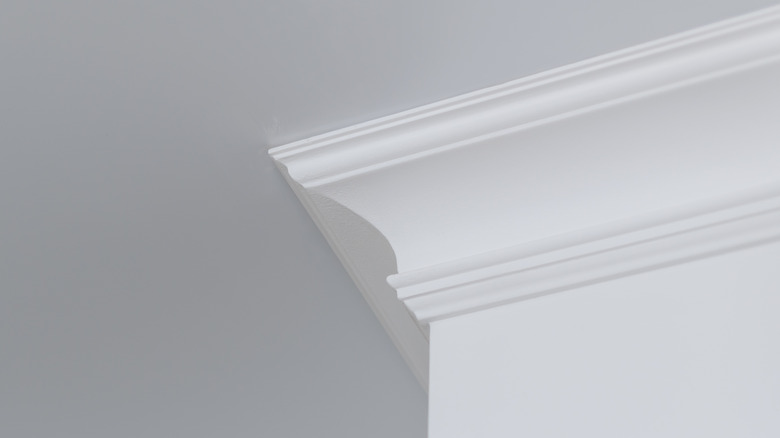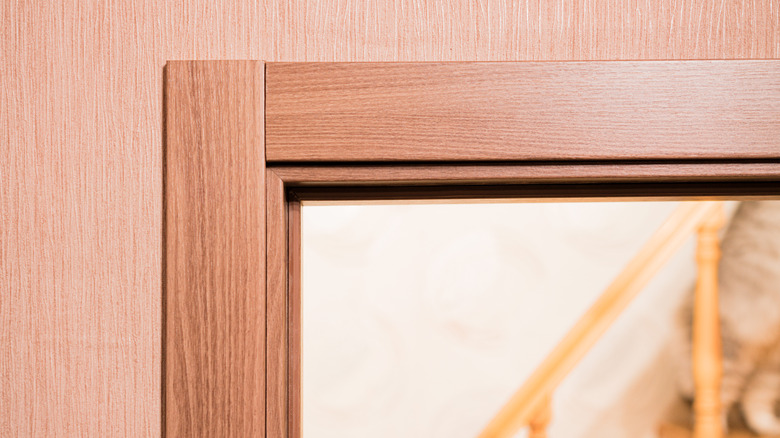10 Types Of Wall Moldings To Consider Before Remodeling Your Home
Taking on a home project, whether it is a small update or an entire remodel, is exciting. No matter how big the project, making changes to your walls using moldings is an easy way to add character to your home. But, what exactly are wall moldings, you ask? To put it simply, they are a form of décor using special boards plastered to your walls with a strong glue, according to Treehouse.
You have probably noticed baseboards or crown moldings in many homes you've walked into because they're the most common types. But, there are a multitude of ones you might want to consider beyond those. There are a number of benefits that come with installing moldings. They make your space more decorative, increase the value of your home if you decide to put it on the market, enhance its visual appeal, and can hide imperfections such as cracks in the walls, per Bear Mountain Custom Painting. Here are some moldings to consider.
Chair rail
Originally designed to prevent chairs or furniture from damaging the walls, per The Spruce, a chair rail is a piece of trim about 3 to 4 feet from the ground. They're now looked upon as a more decorative than functional, but the lower level of wainscot below the rail still serves as protection. True to the original concept, chair rails are commonly found in the dining room. Although chair rails are great for adding character and preventing scuffs on your walls, they attract dust, which means they'll need to be cleaned regularly.
The great thing about chair rails is you have two different sections of the wall that you can decorate differently. You can paint the two sections different colors, or add a decorative-style wallpaper to one half of the wall and paint the other half. Chair rails allows you to embrace your creativity and add an elegant look to the room.
Picture rail
Similar to chair rails, picture rails are another piece of trim placed partway on the wall. However, picture rails are normally placed higher up — 1 or 2 feet below the ceiling. According to House Beautiful, these moldings allow you to hang pictures without damaging your walls. Instead of jamming a nail into the wall itself, you hammer the nail directly into the rail, which is a flat board attached to the wall, and hang the artwork on that. Another type of picture rail is a rod from which you can use a wire or cord to hang artwork.
Per Remodelista, these type of moldings are a great option if you're going to be regularly changing the artwork you hang, instead of keeping the same ones hung for years. Picture rails are perfect for spaces where pictures are commonly hung, such as bedrooms, living rooms, and family rooms. They also make for great decorative pieces in hallways. And if you aren't interested in hanging artwork, picture rails still are a charming decorative element that delineates the space.
Crown molding
Crown molding is a traditional trim that is placed at the point where the top of the wall meets the ceiling, according to Angi. It enhances every room, giving them depth and elegance while also making them look taller. There are many detailed crown moldings that are made of wood, PVC, or vinyl. Another option is simple moldings, which are more affordable than the heavily detailed ones.
If you plan on incorporating crown moldings into your home, be sure to match them to your baseboards (if you have any) to create balance. Typically, rooms with high ceilings need thicker moldings so they stand out, while lower ceilings should have thinner pieces. Angi suggests that for a room with 8-foot ceilings, the crown moldings should be no more than 6 inches tall. For a space with 10-foot ceilings, use moldings that are about 8 inches tall, so the room feels proportional.
Casing
Casing is a type of molding that closes the gap between the space of a wall and a door or window, according to Bob Vila. The width of a casing is normally 2 to 3 inches long. There are myriad of casing profiles, per Builders Surplus, such as Colonial, Stafford, Windsor, Belly, and Ranch. The Ranch style is the plainer casing of the ones listed, but it is perfect for a simple look due to its slightly curved design. The Colonial profile is the more classical and traditional casing that many folks tend to go for.
Aside from deciding which style to go with, there are also some materials to consider, according to Metrie. Paint-grade wood is commonly made from poplar and pine, and can be used with a simple style such as Ranch. It's bare wood, so it might need to be primed before painting, unless it comes pre-primed. Stain-grade wood (such as oak, maple, and mahogany) is perfect if your home has a lot of moisture, because it won't warp. Multi-density fiberboard (MDF) is made from resin and sawdust, and is inexpensive and durable. MDF moldings are easy to install, but hard to decorate since they don't have such sharp corners.
Wainscoting
Often placed beneath a chair rail or picture rail, wainscoting is a decorative wood panel, according to Home Depot. Adding wainscoting to your home can create insulation, protect the walls from chairs or other furniture, and be used as décor to elevate the interior of your home, per MasterClass.
There are four common types of wainscoting that you could include in your home, says MasterClass. A simple panel where pieces of wood are attached directly to the wall, known as wall-panel wainscoting, is an easy DIY project and enhances your home quickly. Flat-panel wainscoting (also known as board-and-batten or Shaker) is when thin boards are plastered to the wall. They are then decorated with strips of molding, which create vertical or square framing. Beaded-panel (or beadboard) wainscoting is a large piece of wood with vertical grooves. For those looking for a formal, traditional style, raised-panel wainscoting is the way to go. For this type of wainscoting, a craftsman bevels the edges of the panels and adds wood trim.
Picture-frame molding
One of the more decorative moldings that serves little function is the picture-frame wall, which consists of equally sized moldings that create a framed look, according to The Spruce. Picture-frame moldings are normally located on the bottom half of the wall below the chair rail. They give the home a formal, elegant look which could be handy for those who want their homes to be more sophisticated.
While they don't have a main function in the house, picture-frame moldings serve a decorative purpose and will catch the eye of any guest who enters your home. Because picture-frame moldings lean toward a more formal style, you can be creative with how you use them in your house. While you can go with the classic look of painting them the same color as your wall (creating a shadow effect), you can also paint the inside of the moldings different colors to add a pop of personality to the room.
Baseboards
Like crown moldings, baseboards are one of the most popular types of trim, according to House Beautiful. Baseboards are placed where the wall meets the floor. They play off crown moldings, tying the whole room together. Baseboards are also great for preventing any damage to your walls from shoe scuffs to vacuum jams, per Remodelista. They're often made from solid wood, but can also be made from MDF — which is a good way to go since it is inexpensive and water resistant, preventing water damage.
Baseboards do come in a variety of shapes, according to Home Depot. Rounded or stepped baseboards, in which the top tapers into the wall, are the most popular shapes. They're short in height and give off a simple look that's great for modern homes. Flat baseboards are straightforward. They are completely flat on the front side and have rigid grooves on the back for easier installation. They almost blend into the wall, depending if they're the same color. A sculpted mid-height baseboard is a taller trim that has a scalloped design at the top and works well in more formal homes.
Dentil molding
A great way to add elegance to your home is to put dentil molding on the exterior or interior. Dentil molding is a series of small, rectangular blocks that are placed close together to form a molding, according to ThoughtCo. This type of trim is normally located under the roofline of a building or on the interior's crown molding. Often associated with Classical and Neoclassical architecture, it is purely decorative.
Dentil molding was originally made from stone, but is now often made of PVC, per ThoughtCo. If you're considering dentil molding, you should keep in mind that it's an expensive investment because the rectangular blocks have to be cut and shaped individually to be the same size, according to Kitchen Cabinet Kings. Each piece is also placed one by one to make sure the spacing between one another is perfect, as opposed to other moldings where they are installed all at one time.
Cove
Cove moldings are similar to crown moldings, since they are placed directly below the ceiling. But cove moldings are smooth and concave with a "C" shape, according to Hunker. They are used as a transition between the wall and the ceiling, creating a simple, curved look. Cove moldings come in a variety of widths, even as narrow as ¾ inches, making them a great option for certain woodworking purposes.
These type of moldings are used to add simple touches around your home, especially in areas that already hold fancy detailing. If you want to make them stand out, you can paint them a bold color or install a more detailed cove molding. Even though they're located at the top corners, they can also be used at the bottom corners of the room. It also makes any room appear bigger and can add value to your home if you ever decide to sell it.
Architrave
After installing multiple different moldings to your home, architraves — a type of decorative trim placed above doors and window — can tie the entire home together, according to Australian Moulding. Architraves can make a bare door appear elegant, as they add some decorative details. They're handy for hiding any joints, seams, or gaps in window or door frames from where the plaster is placed.
There are different styles of architraves from different time periods that can be put above doors such as: Colonial, Victorian, Federation, and Art Deco, to name a few. Architraves are also made from a variety of materials, such as hardwood, softwood, and timber. According to Australian Moulding, some common woods used for architraves are clear pine, oak, Western red cedar, Meranti, kin-dried hardwood, and finger-jointed pine. If you live in a locale where you experience extreme hot or cold temperatures, consider using MDF which won't shrink or warp like wood.
